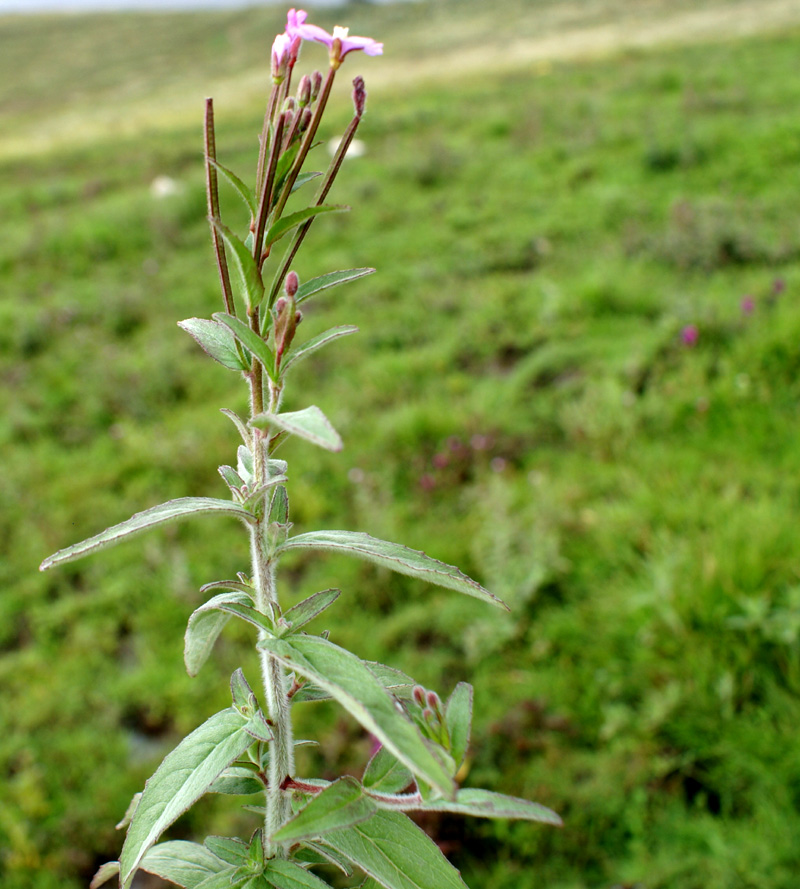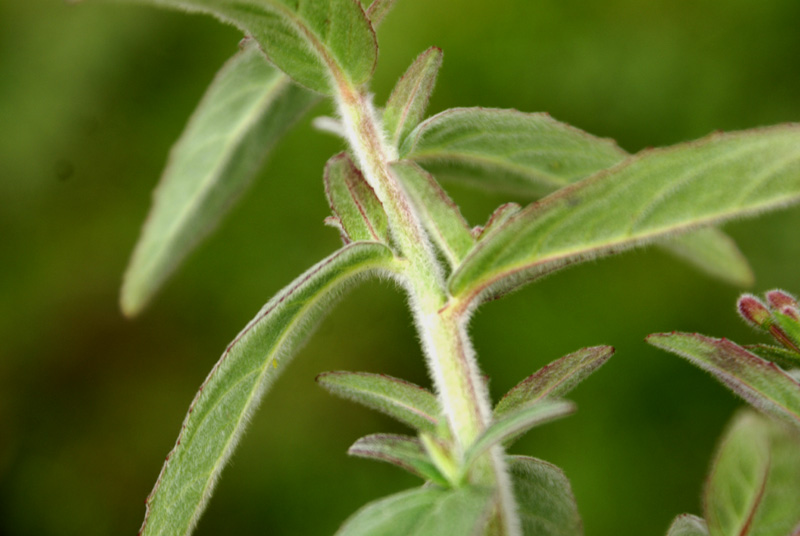|
Epilobium parviflorum Schreb., Spic. Fl. Lips. 155 1771. (Syn: Chamaenerion parviflorum Schreb.; Chamaenerion pubescens (Roth) Moench; Epilobium attenuatum Schur; Epilobium caballeroi Pau; Epilobium cordatum Biv.; Epilobium foliosum Holl & Heynh.; Epilobium hirsutum Huds.; Epilobium knafii Celak.; Epilobium menthoides Boiss. & Heldr.; Epilobium molle Lam.; Epilobium mollissimum Schur; Epilobium neutrum Pall. ex Hausskn.; Epilobium numidicum (Batt.) Batt.; Epilobium opacum Peterm.; Epilobium palustre Willd. [Illegitimate]; Epilobium parviflorum var. menezesii H. Lév.; Epilobium parviflorum var. menthoides (Boiss. & Heldr.) Boiss.; Epilobium parviflorum var. numidicum Batt.; Epilobium parviflorum var. subglabrum W.D.J. Koch; Epilobium pubescens Roth; Epilobium rivulare Hegetschw.; Epilobium stenophyllum Borb.; Epilobium tauschii Knaf ex Hausskn.; Epilobium tetragoniforme Simk.; Epilobium umbrosum Dumort.; Epilobium uralense Hort. Petrop. ex Hausskn.; Epilobium uralense Hausskn.; Epilobium vestitum Benth. ex Wall.; Epilobium villosum Curtis);
.
N. Africa, Europe, Himalaya (Kashmir to Nepal), W. China as per Annotated checklist of Flowering plants of Nepal;
.
Austria, Belgium, England, Czech Republic, Slovakia, Denmark, Finland, Germany, Ireland, Switzerland, Netherlands, Hungary, Norway, Poland, Romania, Sweden, Estonia, Latvia, Lithuania, C-, E- & W-European Russia, Belarus, Ukraine, Madeira, Canary Isl. (La Palma, Gomera, Tenerife, Gran Canaria), Azores, Portugal, Spain, Andorra, Baleares, France, Corsica, Sardinia, Malta, Sicily, Italy, Slovenia, Croatia, Bosnia & Hercegovina, Montenegro, Serbia & Kosovo, Macedonia, Albania, Bulgaria, Greece (incl. Kiklades), Crete, East Aegaean Isl., Rhodos, Crimea, Tunisia, Algeria, Morocco, Northern Caucasus, Armenia, Azerbaijan, Georgia [Caucasus], Kazakhstan, Turkmenistan, Uzbekistan, Tajikistan, Kyrgyzstan, Jammu & Kashmir (Kashmir), Pakistan (Baluchistan), Pakistani Kashmir (Gilgit), Nepal, Turkey (E-Anatolia, Inner Anatolia, N-Anatolia, NE-Anatolia, NW-Anatolia: Bithynia, S-Anatolia, SE-Anatolia, SSW-Anatolia, SW-Anatolia, W-Anatolia, WN-Anatolia), Cyprus (C-Mountains), European Turkey, Iran (EC-Iran, N-Iran), Iraq (NE-Iraq), Israel (Rift Valley, N-Israel), Lebanon (Antilebanon, C-Lebanon), Afghanistan (Badakshan), ?Burma, China (Gansu, Guizhou, Hebei, Henan, Hubei, Hunan, Nei Monggol, Shaanxi, Shandong, Shanxi, Sichuan, Yunnan), Tibet, India, New Zealand (I), USA (I) (Michigan (I), Ohio (I), Pennsylvania (I)), Canada (I) (British Columbia (I), Ontario (I)) as per Catalogue of Life;
.
Common name: Small-Flowered Willow-Herb, Hoary Willowherb ;
.
Epilobium parviflorum from Gulmarg, Kashmir: Epilobium parviflorum Schreber, Spicil. Fl. Lips. 146, 155. 1771 syn: Epilobium vestitum Benth. ex Wall.; Epilobium parviflorum Schreber var. vestitum (Benth. ex Wall.) Clarke
Erect robust perennial herb similar to E. hirsutum in 4-lobed stigma but quite distinct in its sub-sessile (and not amplexicaule) leaves, broadest in the basal 1/3 part (and not upper half), smaller deeply notched pink narrower petals, all parts of plant with long villous hairs, densely so on lines below the leaf.
Photographed from Gulmarg Kashmir in July, 2011 Some fotos for you and specially for …, from my garden.
…, now you know why I am interested in seeds and seedpods. They look so beautiful and every plant has a differnt method of spreading seeds. In fact Epilobium parviflorum is a weed and grows everywhere all the summer. After making fotos I throw away the seeds and still there are more than enough plants in my garden. . SK 3017 05 October 2021: 8 very high res. images.
Location:Jumla, West Nepal Altitude: 2153m. Date: 17 August 2021 Habit : Wild Epilobium hirsutum L. ? I think Epilobium parviflorum Schreb. as per images and details herein and as per keys from Flora of Pakistan:
Looks correct.
. References:
|
Epilobium parviflorum
Updated on December 24, 2024




